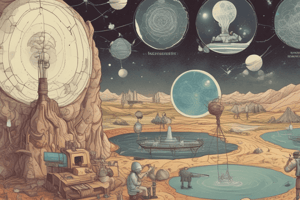Podcast
Questions and Answers
Which of the following is an example of a scientific observation?
Which of the following is an example of a scientific observation?
- Observing the migration patterns of salmon (correct)
- Altering the DNA of cells
- Removing the gene leptin from mice
- Testing the effect of temperature on tomato production
What is the purpose of making observations in scientific research?
What is the purpose of making observations in scientific research?
- To spark new questions
- To alter DNA of cells
- To draw conclusions from patterns
- To gather data to answer questions (correct)
What is the first step of the scientific method?
What is the first step of the scientific method?
- Question
- Experiment
- Observation (correct)
- Hypothesis
What can scientists do with observations that lead to questions?
What can scientists do with observations that lead to questions?
Which of the following is an example of a scientific observation?
Which of the following is an example of a scientific observation?
Why are observations important in science?
Why are observations important in science?
What is the purpose of conducting an experiment after making an observation?
What is the purpose of conducting an experiment after making an observation?
According to the text, what is the definition of observation?
According to the text, what is the definition of observation?
According to the text, what is the definition of inference?
According to the text, what is the definition of inference?
According to the text, what is the relationship between observation and inference?
According to the text, what is the relationship between observation and inference?
According to the text, what is the purpose of scientific observation?
According to the text, what is the purpose of scientific observation?
Flashcards are hidden until you start studying
Study Notes
Scientific Observation and Inference
- Scientific observation is defined as any sensory experience about a natural phenomenon and can occur in a lab setting or the natural world.
- Observations are important in science because they are the starting material for scientific questions and experiments.
- Observations can be used to spark new questions, gather data, and answer questions in scientific research.
- Scientists make observations using a wide variety of techniques, including viewing, microscopy, and other technologies like seismology.
- Observations can be used to draw conclusions and extrapolate meaning from data, along with prior scientific knowledge.
- Examples of scientific observations include noticing leaves changing in the fall, smelling wood burning, and hearing a dog bark at the doorbell.
- Inference is the conclusion drawn based on the facts and evidence available, while observation is the act of monitoring something using senses.
- Observation is the primary source of data collection used in descriptive research, and it involves the collection and recording of data in a systematic manner.
- Inference is a calculated guess based on evidence and circumstances, and it is an element of reasoning and thinking.
- In statistics, inference involves hypothesis testing and estimation, and it is used when studying a large population by selecting a sample.
- Observation and inference are interrelated, with observation being what is noticed and inference being what is deduced based on observations.
- Observation and inference are both important in scientific research to gather empirical evidence and draw meaningful conclusions.
Studying That Suits You
Use AI to generate personalized quizzes and flashcards to suit your learning preferences.




